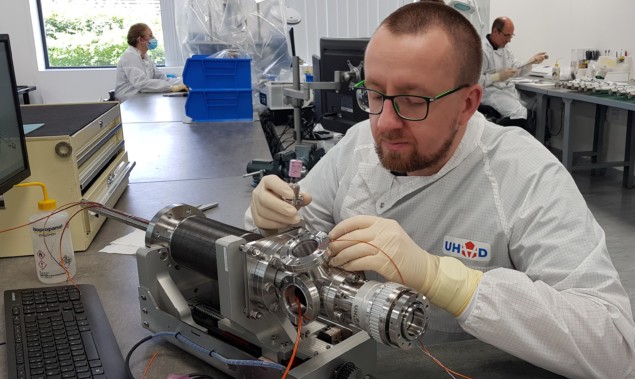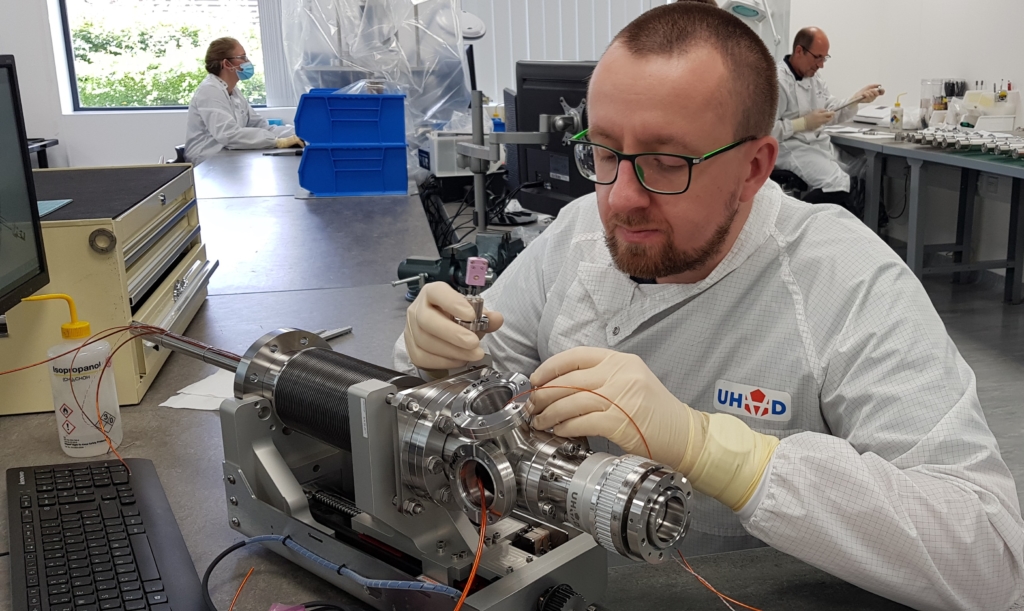UHV Design continues to push the boundaries when it comes to sample manipulation, positioning and preparation in ultrahigh-vacuum environments

There’s much ado about next to nothing, it seems, in the rarefied world of ultrahigh-vacuum (UHV) systems. Operating at pressures of 10–7 Pa and lower, UHV provides a core enabling technology for all manner of surface-science studies that rely on the interaction of photon, electron or ion beams to probe the physical and chemical properties of sample surfaces – among them X-ray photoelectron spectroscopy (XPS), low-energy electron diffraction (LEED) and secondary-ion mass spectroscopy (SIMS). At the same time, UHV conditions ensure that researchers are able to study a chemically clean sample surface free from unwanted adsorbates – also a must-have requirement for thin-film growth and preparation techniques such as molecular beam epitaxy (MBE) and UHV physical vapour deposition (PVD).
Within the UHV environment, the mechanical manipulation, positioning and preparation of the sample represent a complex engineering challenge, typically requiring analytical stages that can deliver a combination of precise linear motion along three axes (xyz) as well as rotation around one or two of those axes (polar and azimuthal). A case in point is the MultiCentre family of analytical stages from UHV Design, a specialist UK developer of UHV motion and heating products. These configurable stages offer scientific users up to five axes of motion alongside options for additional control and testing of the sample, including motorization, temperature measurement, the ability to apply a voltage (sample biasing), heating to 1200 °C, and liquid-nitrogen or liquid-helium cooling.
MultiCentre applications span fundamental research in materials science, particularly at surfaces, as well as thin-film process development and quality control.
Nick Clark, UHV Design
As such, the MultiCentres are an essential building block of analytical experimental techniques for chemical and structural analysis in the fields of thin-film fabrication, semiconductor science, catalysis and nanotechnology, amongst others. “MultiCentre applications span fundamental research in materials science, particularly at surfaces, as well as thin-film process development and quality control,” explains Nick Clark, chief scientist at UHV Design. “The stages and associated accessories are a complete solution for sample manipulation and transfer as well as preparation ahead of analysis – including removal of surface contaminants, crystallization and thin-film deposition.”
Centre stage
The MultiCentre range comprises two main product lines: the general-purpose XL-T series, a compact, single-bellows stage that’s designed specifically for surface-science chambers where space is at a premium; and the XL-R series, a dual-bellows stage with a secondary shaft support and z-axis travel up to 1000 mm – a higher-end specification for surface analytical and synchrotron end-station applications that require longer travel and enhanced stability.
One of the key features of the MultiCentre stages is the motorization of any or all axes of motion, with the emphasis on user-friendly motor assembly and disassembly. “Our motors are neat, compact and easy to remove – a big advantage when it comes to bake-out and maintenance of the UHV chamber and subsystems,” Clark explains. The approach to motorization also plays out in terms of vacuum integrity and mechanical reliability.

Take the four- and five-axis stages, in which the polar and azimuthal axes of rotation exploit magnetically coupled drives. “The use of magnetically coupled drives is fundamentally more reliable because you’re not twisting a bellows around to give you the rotation,” Clark adds. “Ultimately, that means less chance of a vacuum leak, while the drive components are less prone to mechanical damage.”
That focus on user-friendly product design underpins the MultiCentre offering. Many traditional stage designs, for example, require the services to be coiled around the shaft. This increases the swept radius of the stage, creates potential snagging areas and, after multiple cycles, the cooling pipes can fatigue to the point of failure. In contrast, the XL-T series uses the 65 mm internal-diameter bellows bore to route all services – including liquid-nitrogen cooling coils – to yield an uncluttered, compact design at the sample stage.
“The XL-T configuration significantly reduces the swept radius and eliminates the cycling stress on the cooling system whilst freeing up space for sources and detectors to get in close to the sample on multitechnique chambers,” notes Lukasz Rybacki, senior mechanical design engineer at UHV Design. “What’s more, the option to extend functionality when required – such as the addition of extra sample parking stages – provides an economic route to future-proofing your purchase.”
Hot stuff
For the end-user, this “scalability by design” yields significant upside. Customers can choose a four-axis MultiCentre configuration for polar rotation only, or the five-axis system if azimuthal rotation is also required. The same goes for heating and cooling services. If sample heating is needed, options for resistive heating (to 900 °C) and e-beam heating (to 1200 °C) are available.
The former employs a self-supporting tantalum foil heater (for minimum outgassing and a large ratio of heated to open surface area to ensure heater longevity). The foil is also yttria-coated to provide additional robustness in oxidizing atmospheres and for protection in the event of an accidental vent. To upgrade to e-beam heating, which gives users another 300 °C of heating, simply requires a change of power supply unit. An innovative liquid-nitrogen cryomodule provides sample cooling down to –165 °C.
MultiCentres provide continuous azimuthal rotation and temperature measurement even when cooling with liquid nitrogen and when heating to 1200 °C.
Lukasz Rybacki, UHV Design
“In addition,” says Rybacki, “the MultiCentres are unique in their ability to provide continuous azimuthal rotation and temperature measurement even when cooling with liquid nitrogen and when heating to 1200 °C. That functionality can help in the uniform growth and crystallization of thin films and the uniform removal of material during depth-profiling experiments.”
Finally, all XL-T and XL-R MultiCentre stages can be configured to accept the most common surface analysis sample holders, including pucks, flags and ESCA stubs. A lot of attention has also gone into the design of the sample holder to make sure it is virtually nonmagnetic and therefore compatible with low-energy analysis techniques – such as angle-resolved photoelectron spectroscopy (ARPES) – which are very sensitive to magnetism.
MultiCentre stages: versatile by design
UHV Design’s MultiCentre analysis stages are “a complete solution” for surface-science studies, combining sample manipulation, transfer and preparation – including removal of surface contaminants, crystallization and thin-film deposition. A selection of leading-edge applications is highlighted below.
- A four-axis MultiCentre XL-T stage with heating, liquid-nitrogen cooling and deposition shielding supports an advanced UHV system capability at the Centre for Designer Quantum Materials, University of St Andrews, UK. Phil King and colleagues are investigating the electronic structure and many-body interactions of quantum materials using electron spectroscopy as well as creating novel designer quantum materials via atomic layer-by-layer growth. Using the XL-T, the researchers are able to prepare spin targets for investigation by their spin- and angle-resolved photoelectron spectroscopy (SARPES) system.
- A Chinese research collaboration, headed up by Qing Huan and Kui Jin at the Institute of Physics, Chinese Academy of Sciences, Beijing, has developed a custom UHV facility to accelerate advanced materials discovery. Comprising a combinatorial laser MBE system and an in-situ scanning tunnelling microscope (STM), the six-chamber UHV system provides high-throughput film synthesis techniques and subsequent rapid characterization of surface morphology and electronic states of the resulting combinatorial thin films. The preparation chamber is installed with a customized MultiCentre analytical stage and an ion gun, allowing cycles of ion bombardment and annealing of the sample (up to 1200 °C).
- Two highly customized MultiCentre stages are being put to use by the Nanoscale Processes and Measurements Group at the US National Institute of Standards and Technology (NIST) in Gaithersburg, Maryland. A high-temperature XL-T stage (operating at up to 1200 °C and tilting along a non-standard axis) supports crystalline thin-film growth analysis using reflection high-energy diffraction (RHEED), while a high-voltage (20 kV) XL-T stage is being applied in field-ion microscopy (FIM) imaging and preparation of scanning tips for UHV, cryogenic, high-magnetic-field STM studies.
